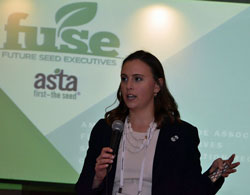Tis the Season for greetings and well wishes.
Today’s holiday cheer comes from the Council for Agricultural Science and Technology.
Sending warm thoughts and best wishes for a wonderful holiday and a very Happy New Year!
Tis the Season for greetings and well wishes.
Today’s holiday cheer comes from the Council for Agricultural Science and Technology.
Sending warm thoughts and best wishes for a wonderful holiday and a very Happy New Year!
 Welcome to ZimmCast number 495! Wow, just five more until we hit the big 5-00!
Welcome to ZimmCast number 495! Wow, just five more until we hit the big 5-00!
This week’s ZimmCast is from last week’s American Seed Trade Association (ASTA) CSS 2015 and Seed Expo and it’s about AgVocating, a word that has become a part of the agricultural dictionary in the past couple of years and has a pretty obvious meaning combining the two words agriculture and advocate.
 Bayer CropScience launched their #AgVocate initiative during the 2015 Farm Progress Show and I had the opportunity to visit with Vice President for Marketing David Hollinrake during ASTA CSS/Seed Expo to learn how that has been going in the past few months. We also talked about the company’s involvement at the seed industry’s main education and trade show event of the year, and some of the great products that Bayer offers for farmers, like the LibertyLink system for weed control.
Bayer CropScience launched their #AgVocate initiative during the 2015 Farm Progress Show and I had the opportunity to visit with Vice President for Marketing David Hollinrake during ASTA CSS/Seed Expo to learn how that has been going in the past few months. We also talked about the company’s involvement at the seed industry’s main education and trade show event of the year, and some of the great products that Bayer offers for farmers, like the LibertyLink system for weed control.
Listen to this week’s ZimmCast here: ZimmCast with David Hollinrake, Bayer CropScience
A recent ZimmComm poll asked the question, Does your agribusiness/operation have a crisis communications plan?” and I was surprised and honestly a bit disturbed as a former public relations person, that so many respondents didn’t believe a crisis communications plan was necessary. And this in light of the rise in undercover videos, avian flu outbreaks, meatless Mondays, (cow farts causing) climate change, and more. To learn more about why ALL agribusinesses should have a crisis communications plan, I reached out to a highly respected and well known crisis firm, Wixted & Company, and spoke with Principal and Founder Eileen Wixted.
 “In today’s highly connected technological environment in which we operate, having a crisis communications plan is just really smart business risk mitigation,” said Wixted. “Your brand, your reputation, your relationship with your customers, your ability to continue to be successful, frequently hinges not only on your operational excellence, but also on how people feel and what they believe about your company. Having a crisis communications plan in place allows you to be able to execute and implement strategies when the unthinkable happens. It really should be viewed as a must have business plan.”
“In today’s highly connected technological environment in which we operate, having a crisis communications plan is just really smart business risk mitigation,” said Wixted. “Your brand, your reputation, your relationship with your customers, your ability to continue to be successful, frequently hinges not only on your operational excellence, but also on how people feel and what they believe about your company. Having a crisis communications plan in place allows you to be able to execute and implement strategies when the unthinkable happens. It really should be viewed as a must have business plan.”
Wixted noted that back in the 1980s, a crisis was defined very differently than a crisis is defined today. In the 1980s a crisis was anything that went boom in the night or involved an issue leading to a significant health complication. Today, she explained, a crisis can begin when you have interns or employees doing inappropriate things and then self-posting.
“All of a sudden the picture or Tweet goes viral and the world looks at your company and makes decisions about the culture of your company because of a social media post,” said Wixted. “People must begin looking at crisis differently. How you respond frequently defines your company culture and whether or not you are able to move forward unscathed.”
She notes that a crisis situation is what is called a high risk low frequency event. It’s high risk because your company must respond with operational excellence while communicating their action plan while the world may be watching. Most crises are low-frequency and most people don’t have experience in dealing with a crisis- this may be the first time in their long successful career when they are on the frontlines. Eileen uses the example of the avian flu outbreak and undercover videos on how to best manage a crisis.
![]() Wixted stressed that what is really important is to do your crisis planning when you don’t have a crisis. “As people are getting ready to move into the new year, I think an important business resolution is to be prepared for the unthinkable,” Wixted said in terms of what are we going to say, whose going to say it and when are we going to say it during a crisis. “Because at the end of the day, a well thought out crisis plan provides guidance the confidence that you will be able to manage your organization through a high risk, low frequency event.”
Wixted stressed that what is really important is to do your crisis planning when you don’t have a crisis. “As people are getting ready to move into the new year, I think an important business resolution is to be prepared for the unthinkable,” Wixted said in terms of what are we going to say, whose going to say it and when are we going to say it during a crisis. “Because at the end of the day, a well thought out crisis plan provides guidance the confidence that you will be able to manage your organization through a high risk, low frequency event.”
Eileen along with the Wixted & Company team can be reached at 515-226-0818 or by visiting www.thinkwixted.com. Learn more about why your organization should have a crisis communications plan by listening to my interview with Eileen Wixted: Interview with Eileen Wixted, Wixted & Company
 The American Seed Trade Association’s Future Seed Executives (FuSE) subcommittee is blazing new trails for 2016.
The American Seed Trade Association’s Future Seed Executives (FuSE) subcommittee is blazing new trails for 2016.
FuSE chair Sarah Neuharth with DuPont Pioneer says the goal of the committee is to educate and support seed industry professionals with fewer than seven years of seed industry experience. “I think a lot of people don’t understand or recognize that FuSE can be a good fit for them,” said Neuharth.
In the coming year, FuSe intends to expand some of its already successful programs, including Office Hours, educational programming and Campus Connections, which is a talent pipeline for the industry directed towards college students. Neuharth says she is in the industry today as a direct result of Campus Connections. “When ASTA’s annual convention was in San Antonio, I applied and was accepted into the program,” she said. “I was an agriculture education major and after my experience with ASTA and my mentor Risa DeMasi, I actually decided to change my major.” Neuharth ended up majoring in crop science and went to work for DuPont Pioneer. “And three and a half years later, I find myself in the seed industry still today and it’s the best thing!” she said.
Neuharth says they would like to see more companies get involved in the FuSe program and she encourages them to do so. “It’s really about finding those people that fit that FuSE demographic and encouraging them to be involved.”
Find out more in this interview: Interview with Sarah Neuharth, FuSe Chair
 Leroy Startz, Chair of the ARA Conference Planning Committee since 2009, spoke with Chuck Zimmerman while at the ARA Conference & Expo in Palm Desert, CA recently.
Leroy Startz, Chair of the ARA Conference Planning Committee since 2009, spoke with Chuck Zimmerman while at the ARA Conference & Expo in Palm Desert, CA recently.
After wrapping up a busy week, Startz was pleased with the overall event. He highlighted the importance of early planning to put together a successful, relevant week for ag retailers. Early planning helps the conference planning committee determine what needs to be discussed, as well as hot-button issues effecting agribusiness retailers. Although outside of the box from traditional presentations, branding, working with media, and millennial concerns were all popular presentations at the conference.
“A lot of these topics are a little foreign to our ag retailers. They work very diligitently to take care of their customers. A lot of times their daily activities get them so focused that they sometimes fail to look forward enough. So our intent is to bring some of these topics to the surface so attendees can immediately take something away from this conference that they can’t get anywhere else.”
With a goal of having 650 registrations for this year’s event, the final attendee registrations totaled over 730, well exceeding expectations. Also increasing are the number of exhibitors as over 100 exhibitors, with an increase in technology companies, were present at this year’s event.
Next year ARA heads to Orlando, FL in December 2016. The Conference Planning Committee will kick of brainstorming and planning for the event in January 2016.
To hear more of Leroy’s interview: Leroy Startz, ARA Conference Planning Chair
The future of agriculture, in particular soybean farming, was on display as the American Soybean Association (ASA) and DuPont announced the latest class of Young Leaders. This news release from ASA says the leadership journey recently began at DuPont Pioneer headquarters in Johnston, Iowa.

The Johnston training session was the first phase of a program designed to identify new and aspiring leaders and provide them with opportunities to enhance their skills and network with other growers. Representatives from 23 states and Canada participated in training that included educational and skill-building components.
“The ASA DuPont Young Leaders Program identifies and trains new and much needed leaders for the soybean industry,” said ASA President Wade Cowan (Texas). “The program provides training and helps them grow their peer network, which strengthens our industry and allows us to work collaboratively in our local, state and national organizations. This year’s class is exceptional; they’re engaged, talented and passionate about agriculture. The program continues to have an enormous impact on not only the soybean industry but all of agriculture.”
The 2016 ASA DuPont Young Leaders are: Brady Peek, Ala.; Derek Holden &Amanda Crangle, Ark.; Jeff and Dianne Barlow, Canada; Aaron & Melanie Thompson, Del.; Brian Ogletree, Ga.; Alan Hill, Ill.; John Wildermuth, Ind.; Ethon Smith, Iowa; Matthew Atkinson & Mary Ann Ross, Kan.; Ben & Katie Furnish, Ky.; Adam & Lindsey Hendricks, Ky.; Vincent Cannatella, La.; Nik Morris, La.; Mike Opificius, Mich.; Rodd & Jamie Beyer, Minn.; Taylor & Rebecca Tesch, Minn.; Paul Muirhead, Miss.; Andrew & Jennifer Lance, Mo.; John & Stephanie Thompson, Mo.; Wade Walters, Neb.; Brett Medlin, N.C.; Greg & Monica Gussiaas, N.D.; Luke Ryan, Ohio; Patrick Burch & Grace Walter, S.C.; Joshua & Kara Kayser, S.D.; Don Holbert, Tenn.; Brett Wightman, Va.; John Mills, Va.; and Rochelle & Evan Schnadt, Wis.
“It was a privilege to meet this year’s enthusiastic class of DuPont Young Leaders, who will take on the challenges and opportunities that face American agriculture,” said Steve Reno, Vice President, Regional Business Director – U.S. & Canada. “We look forward to watching them continue to develop their leadership skills throughout the remaining parts of the program.”
 Agri-Pulse Open Mic this week features Rep. Collin Peterson,ranking member of the House Agriculture Committee.
Agri-Pulse Open Mic this week features Rep. Collin Peterson,ranking member of the House Agriculture Committee.
In this interview, the Minnesota Democrat shares his concerns with the current farm law and on how farmers are using its risk management tools. Peterson identifies what he sees as two flaws in the Supplemental Nutrition Assistance Program and shares his thoughts following a recent hearing on the Farm Credit System. Peterson says it’s too soon to pass judgement on the Trans-Pacific Partnership trade deal and believes it may be an uphill battle to find congressional approval.
Click here to listen to Agri-Pulse Open Mic with Rep. Collin Peterson.
 In a legal opinion released on Monday, the Government Accountability Office (GAO) found that the Environmental Protection Agency (EPA) “violated publicity or propaganda and anti-lobbying provisions contained in appropriations acts with its use of certain social media platforms in association with its Waters of the United States (WOTUS) rulemaking.”
In a legal opinion released on Monday, the Government Accountability Office (GAO) found that the Environmental Protection Agency (EPA) “violated publicity or propaganda and anti-lobbying provisions contained in appropriations acts with its use of certain social media platforms in association with its Waters of the United States (WOTUS) rulemaking.”
According to the GAO:
Specifically, EPA violated the publicity or propaganda prohibition though its use of a platform known as Thunderclap that allows a single message to be shared across multiple Facebook, Twitter, and Tumblr accounts at the same time. EPA engaged in covert propaganda when the agency did not identify EPA’s role as the creator of the Thunderclap message to the target audience. The agency’s #DitchtheMyth and #CleanWaterRules social media campaigns did not implicate the publicity or propaganda prohibition. EPA also violated anti-lobbying provisions though its hyperlinks to certain external Web pages in an EPA blog post. Both of the external Web pages led to appeals to the public to contact Congress in support of the WOTUS rule, which taken in context, constituted appeals to contact Congress in opposition to pending legislation. EPA associated itself with these messages through its decision to include the hyperlinks in its blog post.
“It’s clear from this report that EPA orchestrated this matter in a biased fashion,” said American Farm Bureau Federation (AFBF) president Bob Stallman in a statement. “Courts already have declared serious doubts about the legal authority for the rule. Now that it has become clear that the agency used illegal tactics to manufacture ill-informed support for the rule, Congress should act immediately to prohibit implementation of this rule, which is the product of an unlawful and misguided process.”
The GAO investigation was conducted at the request of Senate Environment and Public Works Chairman Jim Inhofe (R-OK).
 Today the FAA announced new regulations requiring drone (UAS) registration for recreational and hobby users of UAS. The registration process is for owners of small unmanned aircraft weighing more than 0.55 pounds and less than 55 pounds, including payloads such as on-board cameras or sensors.
Today the FAA announced new regulations requiring drone (UAS) registration for recreational and hobby users of UAS. The registration process is for owners of small unmanned aircraft weighing more than 0.55 pounds and less than 55 pounds, including payloads such as on-board cameras or sensors.
Those 13 and older who have purchased a drone prior to December 21, 2015, must register no later than February 19, 2016. Owners of any UAS purchased after December 21, 2015 must register before the first flight outdoors. The registration is valid for three years. The normal registration fee is $5, but in an effort to encourage as many people as possible to register quickly, the FAA is waiving this fee for the first 30 days (from Dec. 21, 2015 to Jan 20, 2016).
“Make no mistake: unmanned aircraft enthusiast are aviators, and with that title comes a great deal of responsibility,” said U.S. Transportation Secretary Anthony Foxx. “Registration gives us an opportunity to work with these users to operate their unmanned aircraft safely. I’m excited to welcome these new aviators into the culture of safety and responsibility that defines American innovation.”
According to this study released on Friday, of the 927 incidents recorded, 327 between December 2013 and September 2015 posed proximity dangers. This occurs when an UAS gets within 500 feet of a plane or helicopter OR when a pilot deems a drone as too close and dangerous. The FAA prohibits the use of unmanned aircraft within 5 miles of any airport within the U.S. without permission from air traffic control. One in every five of these incidents occurred within a “no-drone zone” at an airport.
“UAS have important applications for agriculture, and we need rules and regulations that will put this technology in farmers’ hands. The National Corn Growers Association has taken a leadership role on this issue from the beginning, working with the UAS industry, federal regulators, and others to find a way forward. Let’s continue to work together on common-sense rules that create a culture of safety and responsibility, while ensuring farmers have the access, tools, and training to take full advantage of UAS technology,” said Chip Bowling, President of NCGA.
Owners using the model aircraft for hobby or recreation will only have to register once and may use the same identification number for all of their model UAS.
Owners may register through a web-based system at www.faa.gov/uas/registration.
 Farmers are already winning by playing the Bayer CropScience LibertyLink Real Yield Game.
Farmers are already winning by playing the Bayer CropScience LibertyLink Real Yield Game.
I spoke with winner Dane Kief, Rankin, IL and asked him how he learned about the LibertyLink Real Yield Game. He said, “Like a lot of other farmers I spend a lot of time on Twitter. I was just kind of scrolling through and saw it.”
Dane has won a year’s supply of LibertyLink Soybeans and Liberty Herbicide. I asked him about his plans for using his winnings. He says that coincidentally just days before he won he was talking with his Bayer CropScience representative about trying some LibertyLink soybeans. He plans to “go all Liberty” in the coming season. He also recommends playing the game!
Listen to Illinois farmer Dane Kief here: Interview with LibertyLink winner Dane Kief of Illinois